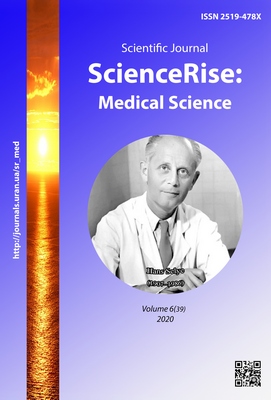Ступінь впливу типів виділених мікрокультур субгінгівальної зони на різні нозологічні форми захворювань пародонта у осіб молодого віку
DOI:
https://doi.org/10.15587/2519-4798.2020.221130Ключові слова:
захворювання тканин пародонта, особи молодого віку, рання діагностика, субгінгівальний мікробіоценозАнотація
Розвиток та перебіг захворювань пародонта у осіб молодого віку характеризується в’ялою клінічною симптоматикою, а на початковій стадії протікає безсимптомно, що значно ускладнює його своєчасну діагностику. Тому особливо важливими є пошук методів ранньої діагностики та прогнозування захворювань пародонта, що дозволить проводити раціональну комплексну профілактику. Серед причин виникнення захворювань пародонта основна роль належить мікроорганізмам зубної бляшки, що має важливе діагностичне значення.
Мета дослідження. Дослідити склад змішаних мікрокультур бактерій субгінгінгівальної зубної бляшки в осіб молодого віку з різними нозологічними формами захворювань пародонта та оцінити ступінь впливу мікробного фактору на розвиток захворювань пародонта.
Матеріали і методи. Вивчений стан мікробіоценозу в субгінгівальній зоні у 104 осіб із захворюваннями пародонта та у 94 осіб з інтактним пародонтом. Для оцінки вираженості впливу типів виділених мікрокультур субгінгівальної зони на розвиток та прогресування захворювань пародонта у осіб молодого віку був застосований метод альтернативного послідовного аналізу Вальда та формули Байєса.
Результати. При розвитку запального процесу в тканинах пародонта в більшості випадків виявляли культури, що характеризувалися наявністтю поліморфних грамнегативних бактерій, що розвивались, фіксуючись на твердій фазі, а в рідкій фазі містили кокову мікрофлору (53,01±5,48 %). При розвитку генералізованого пародонтиту виявляли збільшувалася кількість мікрокультур із переважанням грам-негативної мікрофлори з вираженими адгезивними властивостями, що зумовили розвиток цих мікрокультур на твердій фазі (61,9±10,6 %). Розрахунок прогностичних коефіцієнтів показав, що наявність мікрокультур, що розвивались у планктонній фазі, але містили грамнегативні паличкоподібні бактерії та коки мали високий ступінь значення у плані розвитку захворювань пародонта (+7,46).
Висновки. При розвитку патологічного процесу в тканинах пародонта, стан мікрофлори змінювався в напрямку збільшення грам-негативної поліморфної мікрофлори з вираженими адгезивними властивостями, які здатні до агрегації (до 53,01 % в хворих з катаральним гінгівітом, до 90,48 % – з генералізованим пародонтитом). Результати підрахунку вираженості впливу типів виділених мікрокультур субгінгівальної зони на розвиток та прогресування захворювань пародонта у осіб молодого віку показали, що прогноз розвитку захворювань пародонта, у чималому ступені, залежить від стану мікробіоценозу субгінгівальної зубної бляшки
Посилання
- Suschenko, A. V., Lepekhina, O. A., Lepekhina, L. I. (2015). Rezultaty issledovaniia rasprostranènnosti patologii parodonta u deteĭ. Mezhdunarodnii zhurnal eksperimentov obrazovaniia, 5, 41.
- Kholodniak, O. V. (2015). Poshyrenist ta struktura zakhvoriuvan tkanyn parodonta v osib molodoho viku. Klinichna ta eksperementalna patolohiia, 14 (3), 159–162.
- Dye, B. A. (2011). Global periodontal disease epidemiology. Periodontology 2000, 58 (1), 10–25. doi: http://doi.org/10.1111/j.1600-0757.2011.00413.x
- Usmanova, I. N., Gerasimova, L. P., Kabirova, M. F. et. al. (2014). Diagnosticheskie kriterii khronicheskogo gingivita i parodontita u lits molodogo vozrasta. Parodontologiia, 4, 44−49.
- Marsh, P. D., Devine, D. A. (2011). How is the development of dental biofilms influenced by the host? Journal of Clinical Periodontology, 38 (11), 28–35. doi: http://doi.org/10.1111/j.1600-051x.2010.01673.x
- Yang, N.-Y., Zhang, Q., Li, J.-L., Yang, S.-H., Shi, Q. (2013). Progression of periodontal inflammation in adolescents is associated with increased number ofPorphyromonas gingivalis,Prevotella intermedia,Tannerella forsythensis, andFusobacterium nucleatum. International Journal of Paediatric Dentistry, 24 (3), 226–233. doi: http://doi.org/10.1111/ipd.12065
- Patini, R., Staderini, E., Lajolo, C. et. al. (2018). Relationship between oral microbiota and periodontal disease: A systematic review. European Review for Medical and Pharmacological Sciences, 22, 5775–5788.
- Pavlenko, O. V., Antonenko, M. Yu., Sydelnikov, P. V. (2009). Planuvannia likuvalno-profilaktychnoï dopomohy khvorym na heneralizovanyy̆ parodontyt na osnovi otsinky ryzyku urazhennia parodontu. Sovremennaia stomatolohyia, 1, 56–60.
- Krebs, K. A., Clem, D. S. (2006). Guidelines for the Management of Patients With Periodontal Diseases. Journal of Periodontology, 77 (9), 1607–1611. doi: http://doi.org/10.1902/jop.2006.069001
- Borisenko, A. V., Kolenko, Iu. G., Mialkіvskii, K. O. (2018) Mіkrobna ekologіia parodonta u osіb molodogo vіku. Sovremennaia stomatologiia, 5, 28–31.
- Dubinin S. I., Zaitsev A. V., Vatsenko A. V. et. al. (2020). Mezhmikrobnye vzaimodeistviia oralnogo biotopa. Georgian Medical News, 299, 131–137.
##submission.downloads##
Опубліковано
Як цитувати
Номер
Розділ
Ліцензія
Авторське право (c) 2020 Maryana Sloboda, Taras Pupin

Ця робота ліцензується відповідно до Creative Commons Attribution 4.0 International License.
Наше видання використовує положення про авторські права Creative Commons CC BY для журналів відкритого доступу.
Автори, які публікуються у цьому журналі, погоджуються з наступними умовами:
1. Автори залишають за собою право на авторство своєї роботи та передають журналу право першої публікації цієї роботи на умовах ліцензії Creative Commons CC BY, котра дозволяє іншим особам вільно розповсюджувати опубліковану роботу з обов'язковим посиланням на авторів оригінальної роботи та першу публікацію роботи у цьому журналі.
2. Автори мають право укладати самостійні додаткові угоди щодо неексклюзивного розповсюдження роботи у тому вигляді, в якому вона була опублікована цим журналом (наприклад, розміщувати роботу в електронному сховищі установи або публікувати у складі монографії), за умови збереження посилання на першу публікацію роботи у цьому журналі.










